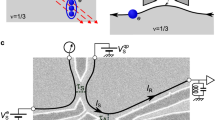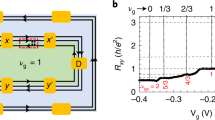Abstract
Since Millikan's famous oil-drop experiments1, it has been well known that electrical charge is quantized in units of the charge of an electron, e. For this reason, the theoretical prediction2,3 by Laughlin of the existence of fractionally charged ‘quasiparticles’—proposed as an explanation for the fractional quantum Hall (FQH) effect—is very counterintuitive. The FQH effect is a phenomenon observed in the conduction properties of a two-dimensional electron gas subjected to a strong perpendicular magnetic field. This effect results from the strong interaction between electrons, brought about by the magnetic field, giving rise to the aforementioned fractionally charged quasiparticles which carry the current. Here we report the direct observation of these counterintuitive entities by using measurements of quantum shot noise. Quantum shot noise results from the discreteness of the current-carrying charges and so is proportional to both the charge of the quasiparticles and the average current. Our measurements of quantum shot noise show unambiguously that current in a two-dimensional electron gas in the FQH regime is carried by fractional charges—e/3 in the present case—in agreement with Laughlin's prediction.
This is a preview of subscription content, access via your institution
Access options
Subscribe to this journal
Receive 51 print issues and online access
$199.00 per year
only $3.90 per issue
Buy this article
- Purchase on Springer Link
- Instant access to full article PDF
Prices may be subject to local taxes which are calculated during checkout




Similar content being viewed by others
References
Millikan, R. A. Electron: Its Isolation and Determination of Some of Its Properties (Univ. Chicago Press, 1917).
Laughlin, R. B. Anomalous quantum Hall effect: an incompressible quantum fluid with fractional charge excitations. Phys. Rev. Lett. 50, 1395–1398 (1982).
Laughlin, R. B. Current status of semionic pairing theory of high-Tcsuperconductors. Int. J. Mod. Phys. B5, 1507–1519 (1991).
von Klitzing, K., Dorda, G. & Pepper, M. New method for high accuracy determination of the fine-structure constant based on quantized Hall resistance. Phys. Rev. Lett. 45, 494–497 (1980).
Tsui, D. C., Stormer, H. L. & Gossard, A. C. Two-dimensional magneto-transport in the extreme quantum limit. Phys. Rev. Lett. 48, 1559–1562 (1982).
Simmons, J. A. et al. Resistance fluctuations in the integral and fractional quantum Hall effect regimes. Phys. Rev. B 44, 12933–12944 (1991).
Byers, N. & Yang, C. N. Theoretical considerations concerning quantized magnetic flux in superconducting cylinders. Phys. Rev. Lett. 7, 46–49 (1961).
Gefen, Y. & Thouless, D. Detection of fractional charge and quenching of the quantum Hall effect. Phys. Rev. B 47, 10423–10436 (1993).
Goldman, V. J. & Su, B. Resonance tunneling in the fractional quantum Hall regime: measurement of fractional charge. Science 267, 1010–1012 (1995).
Franklin, J. D. F. et al. The Aharonov–Bohm effect in the fractional quantum Hall regime. Surf. Sci. 361, 17 (1996).
Prange, R. E. & Girvin, S. M. (eds) The Quantum Hall Effect (Springer, New York, 1987).
Wen, X. G. Chiral Luttinger liquid and the edge excitations in the fractional quantum Hall states. Phys. Rev. B 41, 12838–12844 (1990).
Kane, C. L. & Fisher, M. P. A. Nonequilibrium noise and fractional charge in the quantum Hall effect. Phys. Rev. Lett. 72, 724–727 (1994).
de Chamon, C., Freed, D. E. & Wen, X. G. Tunneling and quantum shot noise in Luttinger liquids. Phys. Rev. B 51, 2363–2378 (1995).
Fendley, A., Ludwig, W. W. & Saleur, H. Exact nonequilibrium DC shot noise in Luttinger liquids and fractional quantum Hall devices. Phys. Rev. Lett. 75, 2196–2199 (1995).
Fendley, P. & Saleur, H. Nonequilibrium DC noise in a Luttinger liquid with an impurity. Phys. Rev. B 54, 10845–10854 (1996).
Lesovik, G. B. Excess quantum shot noise in 2D ballistic point contacts. JETP Lett. 49, 592–594 (1989).
Martin, T. & Landauer, R. Wave packet approach to noise in multichannel mesoscopic systems. Phys. Rev. B 45, 1742–1755 (1992).
Buttiker, M. Scattering theory of current and intensity noise correlations in conductors and wave guides. Phys. Rev. B 46, 12485–12507 (1992).
Reznikov, M., Heiblum, M., Srtikman, H. & Mahalu, D. Temporal correlations of electrons: suppression of shot noise in a ballistic point contact. Phys. Rev. Lett. 75, 3340–3343 (1995).
Kumar, A., Saminadayar, L., Glattli, D. C., Jin, Y. & Etienne, B. Experimental test of the quantum shot noise reduction theory. Phys. Rev. Lett. 76, 2778 (1996).
Saminadayar, L., Glattli, D. C., Jin, Y. & Etienne, B. Observation of the e/3 fractionally charged Laughlin quasiparticles. Phys. Rev. Lett.(submitted).
Acknowledgements
The work was partly supported by a grant from the Israeli Science Foundation and by a grant from the Austrian Ministry of Science.
Author information
Authors and Affiliations
Corresponding author
Rights and permissions
About this article
Cite this article
de-Picciotto, R., Reznikov, M., Heiblum, M. et al. Direct observation of a fractional charge. Nature 389, 162–164 (1997). https://doi.org/10.1038/38241
Received:
Accepted:
Issue Date:
DOI: https://doi.org/10.1038/38241
This article is cited by
-
Evidence for Topological Protection Derived from Six-Flux Composite Fermions
Nature Communications (2024)
-
Partitioning of diluted anyons reveals their braiding statistics
Nature (2023)
-
Anyonic interference and braiding phase in a Mach-Zehnder interferometer
Nature Physics (2023)
-
Single-electron charge transfer into putative Majorana and trivial modes in individual vortices
Nature Communications (2023)
-
Transport measurement of fractional charges in topological models
npj Quantum Materials (2023)
Comments
By submitting a comment you agree to abide by our Terms and Community Guidelines. If you find something abusive or that does not comply with our terms or guidelines please flag it as inappropriate.



